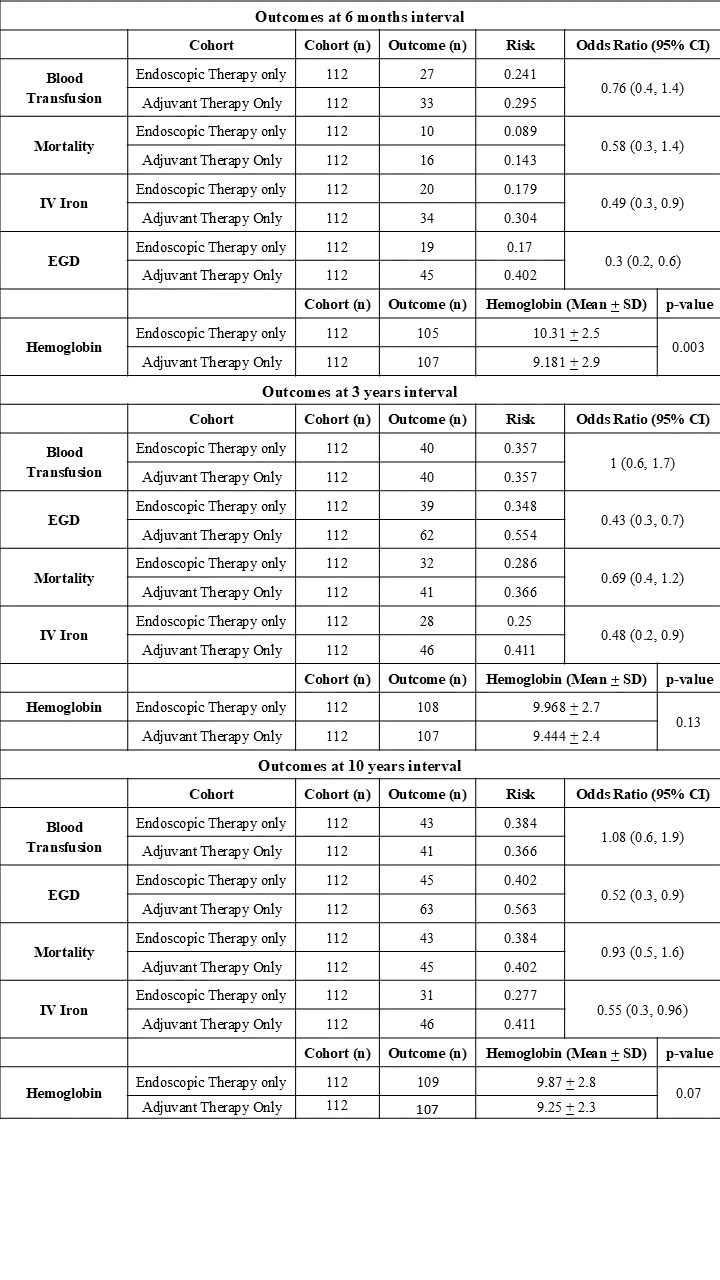Monday Poster Session
Category: GI Bleeding
P3081 - Endoscopic and Medical Therapy May Not Change Significant Clinical Outcomes in Patients Diagnosed With Upper Gastrointestinal Angioectasias Associated With Iron Deficiency Anemia
Monday, October 27, 2025
10:30 AM - 4:00 PM PDT
Location: Exhibit Hall

Muhammad Shikaib Shabbir, MD (he/him/his)
University of California Riverside School of Medicine
San Bernardino, CA
Presenting Author(s)
Muhammad Shikaib. Shabbir, MD1, Umyma Naz, MBBS2, Rajiv Giri, MBBS3, Christian Jackson, MD4
1University of California Riverside School of Medicine, San Bernardino, CA; 2Aziz Fatimah Medical and Dental College, Faisalabad, Punjab, Pakistan; 3Lumbini Medical College, Queens, NY; 4VA Loma Linda Healthcare System, Loma Linda, CA
Introduction: Angioectasias are diagnosed throughout the gastrointestinal tract and frequently lead to hospitalizations and transfusion-dependent anemia. Long-term outcomes of the treatment modalities remain relatively unexplored in angioectasias located in the upper gastrointestinal tract.
Methods: This is a retrospective cohort study utilizing TriNetX. ICD codes were used to identify patients with angioectasias of the upper gastrointestinal tract (stomach and duodenum), while excluding patients with Dieulafoy’s lesion of the stomach and duodenum, malignancy of the stomach and duodenum, and angioectasias of the colon. Patients were also required to have a concomitant diagnosis of iron deficiency and must have received at least one blood or intravenous iron transfusion (IV iron). Patients were subsequently divided into two groups: endoscopic and adjuvant therapy group (combination of endoscopic and medical therapy). Endoscopic therapy included CPT codes for diagnostic and therapeutic EGD. Patients with variceal bleeding were also excluded from both the cohorts, as well as patients receiving thalidomide and bevacizumab. Propensity score matching was done to control for various factors. Outcomes were assessed using TriNetX and expressed as adjusted odds ratio(aOR).
Results: At 6 months, IV iron need (17.9% vs. 30.4%, OR 0.499, 95% CI 0.266–0.936), and EGD (17.0% vs. 40.2%, OR 0.304, 95% CI 0.163–0.566) were less compared to those receiving adjuvant therapy. There was no difference in mortality and transfusion rates. Mean hemoglobin levels were significantly higher in the EGD only group (10.31 ± 2.45 vs. 9.18 ± 2.92, p = 0.003).
At 3 years, EGD (34.8% vs. 55.4%, OR 0.431, 95% CI 0.251–0.738) and IV iron (25.0% vs. 41.1%, OR 0.478, 95% CI 0.271–0.846) remained significantly lower in the endoscopic group. Mortality, blood transfusion rates as well as mean hemoglobin were nonsignificant. At 10 years, reduced need for EGD (40.2% vs. 56.3%, OR 0.522, 95% CI 0.307–0.888) and IV iron (27.7% vs. 41.1%, OR 0.549, 95% CI 0.314–0.961) was demonstrated in the endoscopic therapy group. Differences in mortality, blood transfusion rates, and hemoglobin level remained statistically nonsignificant for 10 years.
Discussion: Adjuvant therapy, when compared to endoscopic therapy alone, may not provide a significant advantage in treating patients with angioectasias of the upper GI tract with iron deficiency anemia. Prospective, multicenter randomized controlled trials will need to be performed for further validation.

Figure: Outcomes for Endoscopic versus Adjuvant Therapy at 6 months, 3 years, and 10 years intervals
Disclosures:
Muhammad Shabbir indicated no relevant financial relationships.
Umyma Naz indicated no relevant financial relationships.
Rajiv Giri indicated no relevant financial relationships.
Christian Jackson indicated no relevant financial relationships.
Muhammad Shikaib. Shabbir, MD1, Umyma Naz, MBBS2, Rajiv Giri, MBBS3, Christian Jackson, MD4. P3081 - Endoscopic and Medical Therapy May Not Change Significant Clinical Outcomes in Patients Diagnosed With Upper Gastrointestinal Angioectasias Associated With Iron Deficiency Anemia, ACG 2025 Annual Scientific Meeting Abstracts. Phoenix, AZ: American College of Gastroenterology.
1University of California Riverside School of Medicine, San Bernardino, CA; 2Aziz Fatimah Medical and Dental College, Faisalabad, Punjab, Pakistan; 3Lumbini Medical College, Queens, NY; 4VA Loma Linda Healthcare System, Loma Linda, CA
Introduction: Angioectasias are diagnosed throughout the gastrointestinal tract and frequently lead to hospitalizations and transfusion-dependent anemia. Long-term outcomes of the treatment modalities remain relatively unexplored in angioectasias located in the upper gastrointestinal tract.
Methods: This is a retrospective cohort study utilizing TriNetX. ICD codes were used to identify patients with angioectasias of the upper gastrointestinal tract (stomach and duodenum), while excluding patients with Dieulafoy’s lesion of the stomach and duodenum, malignancy of the stomach and duodenum, and angioectasias of the colon. Patients were also required to have a concomitant diagnosis of iron deficiency and must have received at least one blood or intravenous iron transfusion (IV iron). Patients were subsequently divided into two groups: endoscopic and adjuvant therapy group (combination of endoscopic and medical therapy). Endoscopic therapy included CPT codes for diagnostic and therapeutic EGD. Patients with variceal bleeding were also excluded from both the cohorts, as well as patients receiving thalidomide and bevacizumab. Propensity score matching was done to control for various factors. Outcomes were assessed using TriNetX and expressed as adjusted odds ratio(aOR).
Results: At 6 months, IV iron need (17.9% vs. 30.4%, OR 0.499, 95% CI 0.266–0.936), and EGD (17.0% vs. 40.2%, OR 0.304, 95% CI 0.163–0.566) were less compared to those receiving adjuvant therapy. There was no difference in mortality and transfusion rates. Mean hemoglobin levels were significantly higher in the EGD only group (10.31 ± 2.45 vs. 9.18 ± 2.92, p = 0.003).
At 3 years, EGD (34.8% vs. 55.4%, OR 0.431, 95% CI 0.251–0.738) and IV iron (25.0% vs. 41.1%, OR 0.478, 95% CI 0.271–0.846) remained significantly lower in the endoscopic group. Mortality, blood transfusion rates as well as mean hemoglobin were nonsignificant. At 10 years, reduced need for EGD (40.2% vs. 56.3%, OR 0.522, 95% CI 0.307–0.888) and IV iron (27.7% vs. 41.1%, OR 0.549, 95% CI 0.314–0.961) was demonstrated in the endoscopic therapy group. Differences in mortality, blood transfusion rates, and hemoglobin level remained statistically nonsignificant for 10 years.
Discussion: Adjuvant therapy, when compared to endoscopic therapy alone, may not provide a significant advantage in treating patients with angioectasias of the upper GI tract with iron deficiency anemia. Prospective, multicenter randomized controlled trials will need to be performed for further validation.

Figure: Outcomes for Endoscopic versus Adjuvant Therapy at 6 months, 3 years, and 10 years intervals
Disclosures:
Muhammad Shabbir indicated no relevant financial relationships.
Umyma Naz indicated no relevant financial relationships.
Rajiv Giri indicated no relevant financial relationships.
Christian Jackson indicated no relevant financial relationships.
Muhammad Shikaib. Shabbir, MD1, Umyma Naz, MBBS2, Rajiv Giri, MBBS3, Christian Jackson, MD4. P3081 - Endoscopic and Medical Therapy May Not Change Significant Clinical Outcomes in Patients Diagnosed With Upper Gastrointestinal Angioectasias Associated With Iron Deficiency Anemia, ACG 2025 Annual Scientific Meeting Abstracts. Phoenix, AZ: American College of Gastroenterology.
